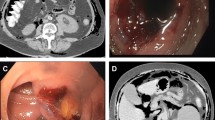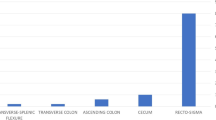Abstract
Background
Colonoscopy is an established tool for the diagnosis and management of colonic and rectal pathology. Even though colonic perforation is rare after colonoscopy, it is a serious and typical complication. The definitive management remains controversial. Both operative and nonoperative techniques have been described in the literature, though the standard treatment for these patients is still an operative repair of the perforation site. Recently, endoscopic clip application was recommended, particularly for iatrogenic perforations, but less is known about the effectiveness of endoluminal repair of colonic perforations with clips.
Methods
In this series, 7589 colonoscopies were performed over a 34-month period in a tertiary-level referral center. Three perforations occurred during 5413 diagnostic colonoscopies. Therapeutic colonoscopy was under taken in 2176 patients, resulting in a total of 27 perforations. Out of 30 patients with colonic perforation, five patients underwent operative management and 25 patients were subsequently treated nonoperatively.
Results
In 27 patients, endoscopic application of inert metallic clips was used for closure of iatrogenic perforation. Twenty-five of these patients were treated non-operatively, while two patients underwent surgery. The mean postoperative length of hospitalization for patients was 12.2 days, compared to 3.5 days for patients treated conservatively.
Conclusions
Endoluminal repair of colonic perforations with clips and further conservative treatment seems to provide a tool that avoids the major additional trauma associated with laparotomy or laparoscopy and minimizes the length of hospitalization.

Similar content being viewed by others
References
Cobb WS, Heniford BT, Sigmon LB, Hasan R, Simms C, Kercher KW, Matthews BD (2004) Colonoscopic perforations: incidence, management, and outcomes. Am Surg 70(9):750–7; discussion 757–8
Ker TS, Wasserberg N, Beart RW Jr. (2004) Colonoscopic perforation and bleeding of the colon can be treated safely without surgery. Am Surg 70(10):922–4
Rex DK, Rahmani EY, Haseman JH, Lemmel GT, Kaster S, Buckley JS (1997) Relative sensitivity of colonoscopy and barium enema for detection of colorectal cancer in clinical practice. Gastroenterology 112(1):17–23
Lo AY, Beaton HL (1994) Selective management of colonoscopic perforations. J Am Coll Surg 179(3):333–7
Nelson RL, Abcarian H, Prasad ML (1982) Iatrogenic perforation of the colon and rectum. Dis Colon Rectum 25(4):305–8
Fruhmorgen P, Demling L (1979) Complications of diagnostic and therapeutic colonoscopy in the Federal Republic of Germany. Results of an inquiry Endoscopy 11(2):146–50
Iqbal CW, Chun YS, Farley DR (2005) Colonoscopic perforations: a retrospective review. J Gastrointest Surg 9(9):1229–35: discussion 1236
Mandel JS, Bond JH, Church TR, Snover DC, Bradley GM, Schuman LM, Ederer F (1993) Reducing mortality from colorectal cancer by screening for fecal occult blood. Minnesota Colon Cancer Control Study. N Engl J Med 328(19):1365–71
Anderson ML, Pasha TM, Leighton JA (2000) Endoscopic perforation of the colon: lessons from a 10-year study. Am J Gastroenterol 95(12):3418–22
Rogers BH, Silvis SE, Nebel OT, Sugawa C, Mandelstam P (1975) Complications of flexible fiberoptic colonoscopy and polypectomy. Gastrointest Endosc 22(2):73–7
Gibbs DH, Opelka FG, Beck DE, Hicks TC, Timmcke AE, Gathright JB Jr. (1996) Postpolypectomy colonic hemorrhage. Dis Colon Rectum 39(7):806–10
Smith LE (1976) Fiberoptic colonoscopy: complications of colonoscopy and polypectomy. Dis Colon Rectum 19(5):407–12
Schlinkert RT (1998) Laparoscopic treatment of colonoscopic perforations. Mayo Clin Proc 73(1):98
Agresta F, Michelet I, Mainente P, Bedin N (2000) Laparoscopic management of colonoscopic perforations. Surg Endosc 14(6):592–3
Damore LJ 2nd, Rantis PC, Vernava AM 3rd, Longo WE (1996) Colonoscopic perforations. Etiology, diagnosis, and management. Dis Colon Rectum 39(11):1308–14
Soliman A, Grundman M (1998) Conservative management of colonoscopic perforation can be misleading. Endoscopy 30(9):790–2
Velez MA, Riff DS, Mule JM (1997) Laparoscopic repair of a colonoscopic perforation. Surg Endosc 11(4):387–9
Raju GS, Pham B, Xiao SY, Brining D, Ahmed I (2005) A pilot study of endoscopic closure of colonic perforations with endoclips in a swine model. Gastrointest Endosc 62(5):791–5
Katsinelos P, Beltsis A, Paroutoglou G, Galanis I, Tsolkas P, Mimidis K, Pilpilidis I, Baltagiannis S, Kamberis E, Papaziogas B (2004) Endoclipping for gastric perforation after endoscopic polypectomy: an alternative treatment to avoid surgery. Surg Laparosc Endosc Percutan Tech 14(5):279–81
Binmoeller KF, Grimm H, Soehendra N (1993) Endoscopic closure of a perforation using metallic clips after snare excision of a gastric leiomyoma. Gastrointest Endosc 39(2):172–4
Wewalka FW, Clodi PH, Haidinger D (1995) Endoscopic clipping of esophageal perforation after pneumatic dilation for achalasia. Endoscopy 27(8):608–11
Rodella L, Laterza E, De Manzoni G, Kind R, Lombardo F, Catalano F, Ricci F, Cordiano C (1998) Endoscopic clipping of anastomotic leakages in esophagogastric surgery. Endoscopy 30(5):453–6
Shimamoto C, Hirata I, Umegaki E, Katsu K (2000) Closure of an esophageal perforation due to fish bone ingestion by endoscopic clip application. Gastrointest Endosc 51(6):736–9
Kim HS, Lee DK, Jeong YS, Kim KH, Baik SK, Kwon SO, Cho MY (2000) Successful endoscopic management of a perforated gastric dysplastic lesion after endoscopic mucosal resection. Gastrointest Endosc 51(5):613–5
Karahasanoglu T, Altinli E, Hamzaoglu I, Aydogan F, Dobrucali A (2003) Is intraluminal clip application an appropriate treatment for iatrogenic gastric perforation? Eur Surg Res 35(4):383–7
Forde KA (1992) Therapeutic colonoscopy. World J Surg 16(6):1048–53
Dhalla SS (2004) Endoscopic repair of a colonic perforation following polypectomy using an endoclip. Can J Gastroenterol 18(2):105–6
Mana F, De Vogelaere K, Urban D (2001) Iatrogenic perforation of the colon during diagnostic colonoscopy: endoscopic treatment with clips. Gastrointest Endosc 54(2):258–9
Author information
Authors and Affiliations
Corresponding author
Rights and permissions
About this article
Cite this article
Magdeburg, R., Collet, P., Post, S. et al. Endoclipping of iatrogenic colonic perforation to avoid surgery. Surg Endosc 22, 1500–1504 (2008). https://doi.org/10.1007/s00464-007-9682-1
Received:
Revised:
Accepted:
Published:
Issue Date:
DOI: https://doi.org/10.1007/s00464-007-9682-1




